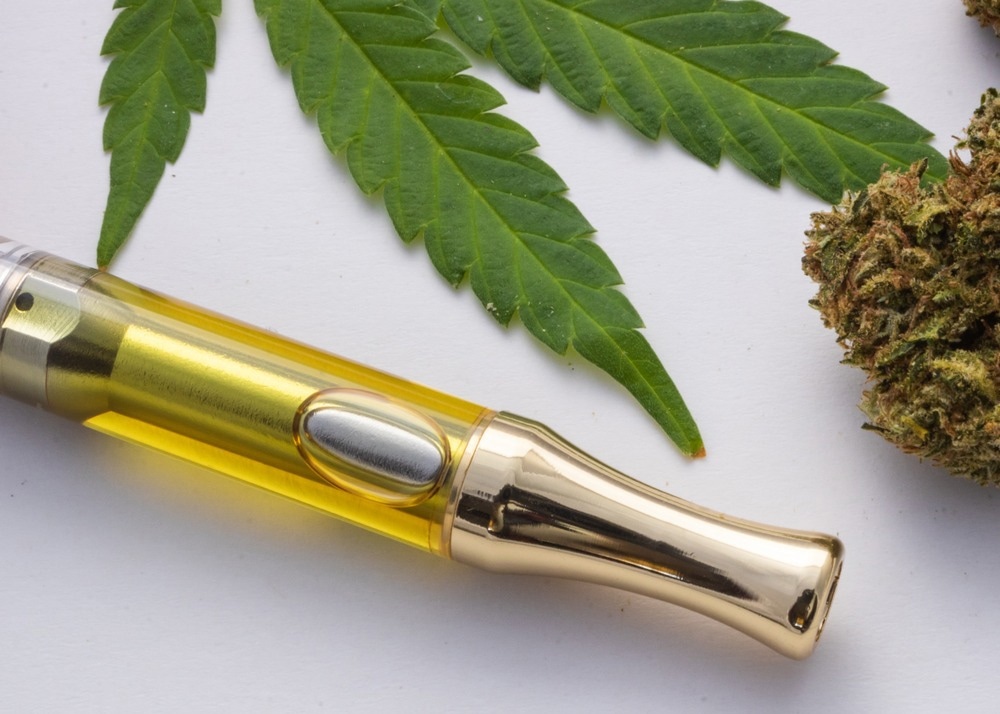In a recent Toxicological Sciences study, scientists assess the challenges presented by cannabinoid vaping products during the analysis of their effect on consumers’ respiratory health.

Study: Cannabinoid Vaping Products Present Novel Challenges for Assessment of Respiratory Health Effects. Image Credit: Shannon L. Price / Shutterstock.com
Cannabinoid vaping products
Some of the common cannabinoid vaping products include D9-tetrahydrocannabinol (D9-THC), D8-tetrahydrocannabinol (D8-THC), as well as cannabidiol (CBD) products.
Several studies related to e-cigarettes or vaping have indicated the adverse effects, particularly in terms of their ability to cause lung injury, associated with cannabinoid vaping products. According to a February 2020 United States Centers for Disease Control and Prevention (CDC) report, 2,807 individuals were hospitalized and 68 deaths occurred due to utilizing cannabinoid vaping products.
Several studies have shown that among e-cigarette/vaping users with product use-associated lung injury (EVALI), 82% reported the use of THC vaping products, while only 16% reported using CBD vaping products.
Two of the main reasons associated with limited research on THC- and CBD-containing vaping products are regulatory factors and the significant evolution of the cannabinoid market. For example, the U.S. Drug Enforcement Agency Controlled Substances Act has classified THC under Schedule 1, which restricts accessibility to THC-containing products for scientific research.
Previous studies have shown that both THC and CBD vaping products contain silicones, humectants, vitamins, flavorants, terpenes, pesticides, and metals. Moreover, cannabinoid vaping products are typically characterized as concentrated “oils” and diluted “vape juice.” Pen-type devices are used for both types of products, in which concentrated oils are used at concentrations ranging from 700 to 1,200 mg/ml and vape juice from 15 to 50 mg/ml.
Since September 2019, D8-THC can be sold legally in many U.S. states. Similar to D8-THC, D9-THC is highly analogous to marijuana use and produces perceptual, somatic, and psychoactive effects. As compared to D8-THC, D9-THC has a less psychoactive effect.
According to a recent study by Google Trends, since August 2020, there has been a significant increase in searches related to D8-THC. This compound is a minor constituent of hemp and can be easily extracted through acid-catalyzed intramolecular cyclization of CBD. The method for the isomerization of CBD to D8-THC is easily available online; however, an improper chemical reaction could lead to product contamination.
Cannabinoid vaping products users
Researchers have pointed to a gap in research associated with the health effects of cannabinoid vaping products, especially related to vaping and inhalational exposures. One of the reasons for this lack of data is that the U.S. cannabinoid market is still relatively new. Interestingly, the majority of data on the effect of cannabinoid vaping products have been associated with adolescents.
According to a recent meta-analysis, the lifetime use of THC vaping products in adolescents was found to increase from 6.1% to 13.6% between 2013 and 2020. These studies reported that adolescents preferred THC vaping oil over cannabis flower.
Similar to this report, a U.S.-based survey showed higher use of cannabinoid vaping products in adolescents and young adults. However, this survey further reports that 26.1% of the adult participants of the study used CBD, while 18.9% used CBD vaping oils.
Previous findings on the health effects of cannabinoid vaping products among U.S. adolescent participants identified an increased risk of multiple respiratory symptoms including wheezing and dry cough. In addition to affecting the lungs, these products also appear to affect the brain and vasculature of users. Furthermore, prenatal studies on THC use have shown altered brain development.
Toxicological assessment of cannabinoid vaping products
In the current study, scientists conducted toxicological profiles of cannabinoid vaping products. Herein, they assessed the relevant dose-response patterns, the toxicity of additives and diluents, as well as inhalational exposures to inform federal policy.
In vitro experiments examining the effect of CBD vaping product exposure on airway epithelial cells have revealed a high concentration of toxicity markers present in exposed cells. Some of these markers include cellular reactive oxygen species, as well as those involved in cytotoxic processes and inflammation.
Recently, the U.S. Cannabis Council examined the chemical content of 16 commercially available D8-THC vaping cartridges. This study showed that all samples contained an increased level of D9-THC as compared to the 0.3% federal limit. Additionally, seven of the 16 samples contained a high level of chromium, nickel, or copper.
Importantly, unknown cannabinoid-like compounds were also found in the samples. Previous studies have shown that synthetic cannabinoid consumption produces psychosis, panic, dysphoria, anxiety, and accidental death in users.
Conclusions
Scientists strongly recommend more research to evaluate the pulmonary toxicity of emerging cannabinoid vaping products, as these studies are essential to determine the effects of these products upon inhalation exposure. More studies are also required to elucidate the cardiovascular and neurological toxicity associated with cannabinoid vaping products.
Journal reference:
- Love, A. C., Schichlein, K. D., Clapp, P. W., et al. (2022). Cannabinoid Vaping Products Present Novel Challenges for Assessment of Respiratory Health Effects. Toxicological Sciences 188(1);1-3. doi:10.1093/toxsci/kfac050.